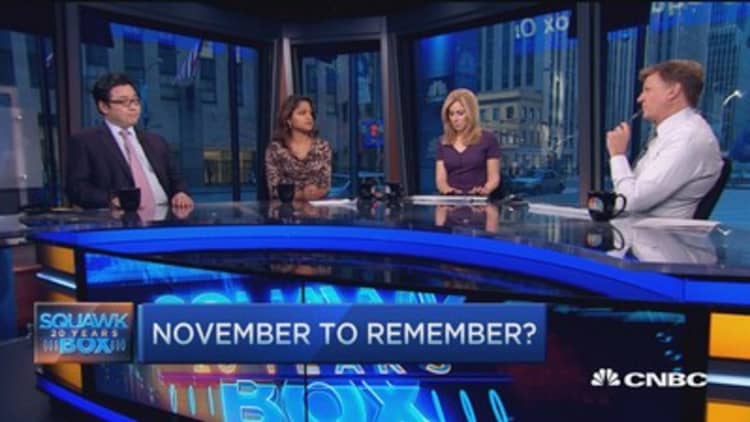
Predictions that a strong historically bearish October may take steam out of what's traditionally been a rally into year-end are overblown, longtime bull Thomas Lee said Tuesday.
"Everybody is saying we're going to flatline into the end of the year. [But] given where short positions are and how much capital is on the sideline maybe ... we end up 10 percent [or] 12 percent for the year," the co-founder of boutique equity research firm Fundstrat Global Advisors said.
"This is a year where people were expecting a lot of bad things to happen. And a lot of bad things did happen, but the market showed a lot of resilience," Lee told CNBC's "Squawk Box," a day after November got off to a rousing start on Wall Street.
Read MoreHedge funder: The winning strategy this year is…
Coming off their best closes in nearly three months, the Dow Jones industrial average joined the and Nasdaq composite in positive territory for the year. As of Monday's close, the Dow was just in the green for 2015, while the S&P was up 2 percent and the Nasdaq was up 8 percent for the year.
Lee said he's not concerned about a possible interest rate increase by the Federal Reserve in December. Whether central bankers hike for the first time in nine years or hold steady again, he sees a bullish outcome.
"Whatever they do in December is going to just confirm underlying trends," giving investors some much-needed clarity, he said.
Read More Bill Daley: Response to Fed rate hike could be big
Defying many predictions, the Fed decided not to move rates higher in September, following the global financial market fallout sparked by concerns about China's economy and whether slowing growth there may spread.
On Aug. 25, the Dow, S&P 500, and Nasdaq dropped to their closing lows of the year. After testing but not breaching those levels over the next month or so, all three measures since the end of September have risen by low double digits.
Fed policymakers held steady again at their October meeting, but warned the markets that December was still a possibility.
One the factors seen as a reason for the Fed's reluctance to hike rates has been stronger dollar. "Consensus thinks the Fed tightens and the dollar strengthens" even further, Lee said. "[But] the dollar has always fallen after the Fed tightens."
Read MoreWhy El-Erian sees 30% US recession risk by 2017
He said when the central bank tightens for reasons other than to slow down the economy, it's essentially confirming "reflationary trends" and that's bad for currencies.
"I know it's counter-intuitive ... [but] we looked a 45 years of data," he said.
Correction: This version was updated to reflect that Lee said reflationary trends are bad for currencies.


